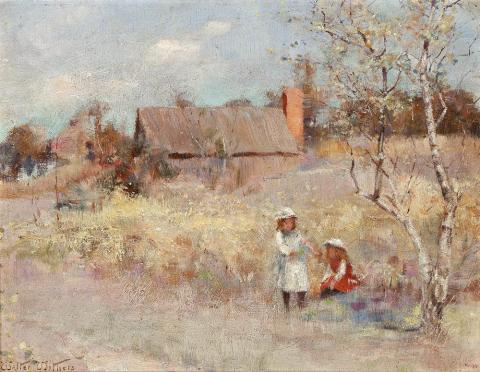MIDSUMMER, c.1895
WALTER WITHERS
oil on board
24.5 x 33.0 cm
signed lower left: Walter Withers
Private collection, Melbourne
Dudley Cain, Melbourne
Lauraine Diggins Fine Art, Melbourne
Private collection, Melbourne
Deutscher-Menzies, Sydney, 7 December 2005, lot 22
Roger Langsworth, Sydney
The Seasons in Australian Art, Lauraine Diggins Fine Art, Melbourne, 20 November – 18 December 1999 and touring to Mosman Art Gallery & Cultural Centre, Sydney; and Customs House Art Gallery, Brisbane, 2000, cat. 19 (illus. in exhibition catalogue)
Topliss, H., The Artists' Camps: 'Plein Air' Painting in Australia, Hedley Australia Publications, Melbourne, 1992, p. 121 (illus.)
Walter Withers’ Midsummer, c.1895 recalls idyllic moments filled with sunlight, recapturing intimate, golden moments of youth. Its imagery and evocative mood are as central to the early Australian Impressionist movement as the heroic imagery of manual labour as in Tom Roberts’ Shearing the Rams, 1890 (National Gallery of Victoria, Melbourne) and Arthur Streeton’s panoramas of noonday light above the Hawkesbury River. Like his friend and contemporary Frederick McCubbin, Withers was a master in essaying the dispositions of nature as in Tranquil Winter, 1895 (National Gallery of Victoria, Melbourne) and The Coming Storm – The Last of Summer 1898 (Art Gallery of Ballarat, Victoria). These middle years of the 1890s, to which our painting Midsummer belongs, were ones of particular achievement for Withers, regarded by many as his best. His mastery of landscape painting was readily recognized in 1897, when his painting The Storm, 1896 won the first Wynne Prize (he won again in 1900), the annual award being established by the Art Gallery of New South Wales for the best landscape painting of the year.
In 1894, Withers and his family had moved back to Heidelberg (which gave its name of the ‘Heidelberg School’ to the Australian Impressionist movement), their cottage being in Cape Street. At the time it looked rather like an English village complete with Gothic-styled churches and gardens abundant with fruit trees, humanised by the presence of people at work, picking flowers, or carting wood. By 1902, in his painting Spring, Withers had blended humanity and nature to the extent of metamorphosing the season into a beautiful young girl, accompanied by lambs, treading lightly in a field of flowers. The model was his daughter Gladys. She and her other sisters were frequent models.1
In Midsummer Gladys is joined by her younger sister Margery to provide an important focus of attention, special colour accents (red in particular), and that humanising touch already mentioned. The lightness of touch is unrivalled. Its sense of immediacy and freshness comes from being painted in the open air directly from the motif. Although Withers painted some grand works of Australiana, as in The Drover, 1912 (Bendigo Art Gallery, Victoria), his was a more modestly based art. Taking the everyday or familiar, he transformed it into something lyrical, adding beauty through the passion of his devotion and technique. This is what characterizes the best in his art. For Midsummer sentiment and sense of recollection are enveloped in the atmospheric haze, gentle soft-edged forms and inviting sweet idleness. Much is due to the freedom of his brush, a field of golden flowers informally brushed in as are a figure or a tree, merged in gentle beauty. These features were recognized and admired by his contemporaries. When Withers included ten landscapes in the October 1894 Annual Exhibition at the Victorian Artists’ Society, The Age reported: ‘His work is characterized by its great charm of colour and by an increased suppleness of execution. He brings before us the evanescent charm of a passing hour and makes us feel the “spirit of the season” in the colour and lighting of his landscape’.2 The exhibition included many marvellous works such as A Bright Winter’s Morn, 1894 acquired that year by the National Gallery of Victoria. The critic’s remarks could apply equally to our painting, which is considered to have been painted the following year.
1. Spring was the seventh panel in a series of paintings commissioned by William Thomas Manifold in 1902. See Mackenzie, A., Walter Withers: The Forgotten Manuscripts, Australian Art Manuscripts Series, Mannagum Press, Lilydale, Victoria, 1987, p. 63 – 4
2. ‘Exhibition of Pictures. The Victorian Artists’ Society’, Age, Melbourne, 25 October 1894, p. 6
DAVID THOMAS
